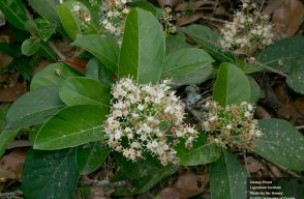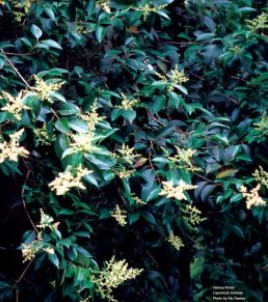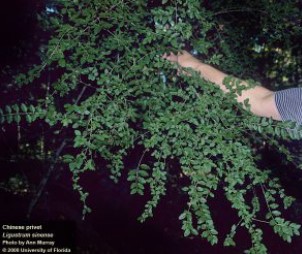By Alicia Halbritter
Ligustrum sinense and Ligustrum lucidum
Two types of privet are found as invasive species in Florida, Chinese Privet (L. sinense) and Glossy Privet (L. lucidum). Both privets are a category 1 invasive according to the Florida Exotic Pest Plant Council (FLEPPC). Ligustrum spp. are native to Asia and boast over 50 varieties, many of which are found in the United States whether that be in natural areas or in cultivation.

Chinese Privet
Ligustrum spp. are a perennial shrubs, with glossy privet reaching heights of 30 feet and chinese privet reaching upwards of 20 feet. Privet can reproduce readily by seed, root, or stump sprouts. Mature trees can produce hundreds of fruit, contributing to the ability of privet to become highly invasive. Both glossy and chinese privet are aggressive growers and will out-compete native vegetation, control measures should be taken to eliminate privets from private and public properties.
Control Methods
Foliar applications of glyphosate or cut-stump applications of triclopyr or glyphosate are effective. Stems <0.5 inch diameter are susceptible to basal bark applications of 20% triclopyr-ester (Remedy) in oil. Larger stems must be notched or frilled.

Glossy Privet
Foliar sprays are effective for dense thickets of Ligustrum. Care must be taken to avoid non-target plants.The ideal time to treat is while plants are in leaf in late autumn or early spring but when many native species are dormant. Triclopyr at 1-2 quarts broadcast rate per acre or 2% solution are recommended.
The cut stump method should be considered when treating individual shrubs. Immediately after cutting stems at or near ground level, apply a 25% solution of glyphosate and water or triclopyr and water to the cut stump, being careful to cover the entire surface. Effectiveness of the herbicide is increased if holes are cut in the top of the freshly felled stump.

Glossy Privet
The basal bark method consists of a mixture of 25% triclopyr and 75% horticultural oil applied to the basal parts of the shrub to a height of 12 to 15 inches from the ground. Thorough wetting is necessary for good control; spray until run-off is noticeable at the ground line.

Chinese Privet
Source : ufl.edu